Shades of Hope
“Shades of Hope” focuses on the artists’ personal interpretations of October 7, emphasizing pain, loss, and uncertainty. The exhibition highlights the understanding that we have no other country… and that nature continues to flourish.
Art offers new life and hope.
The artists present their creations through painting, photography, sculpture, and mixed media, many created specially for this exhibition. The works are also diverse in approach, illustrating personal experiences and insights. The burst of color provides a sense of light and hope, inspiring belief in better days to come.
Curator Galit Zimbalist
Participating artists Anna Ayache, Astar Cohen, Eshed Winkler, Gil Goren, Hanan Shafir, Hilary Piten, Tal Kalman, Leah Gol, Matti Halili, Ziv Ringer.
The Opening 12.7.2024 | 10:30 -13:00
Mamilla Hotel – Level R
Gallery talk 2.8 | Second Gallery talk 20.9
Exhibition ends 30.9
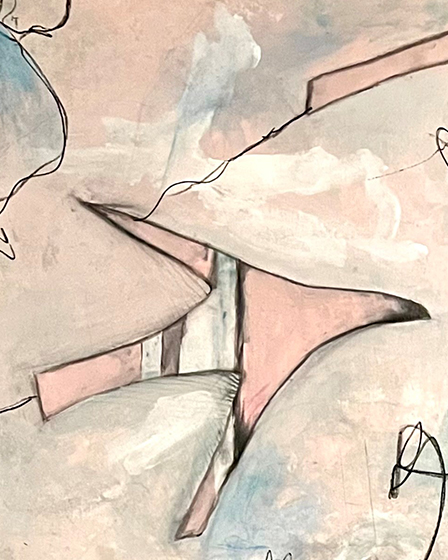
Anna Ayache
“Marionettes, Puppets on a String” | Oil on canvas
“Marionettes, Puppets on a String” is a quartet of paintings depicting innocent birds in shades of blue and pink. It’s a profound, fascinating work of art conveying a social and political message. The birds, free to fly without limitations of place and time, are presented as marionettes, symbolizing a feeling of helplessness and external influence. The use of pleasant, simple shades of pink and blue deepens the contrast between harsh reality and longing for the return of the hostages, military victory, and national unity.
Anna Ayache bonds the opposing worlds that depict her life: in the morning, working at Tel Aviv University’s Faculty of Medicine, and in the evening, painting in an abstract, expressive, intuitive and stormy style.
Ayache’s paintings are usually epitomized by strong colors, a brushstroke that glides from transparency to roughness, deliberate dripping, and an aspiration to touch her own – and the observer’s – deepest layers.
Ayache exhibits in solo and group exhibitions in Israel and around the world, and her works are in private and public collections. Her goal is to profoundly affect the observer’s heart and make him or her reflect, feel, and carry her creation within.
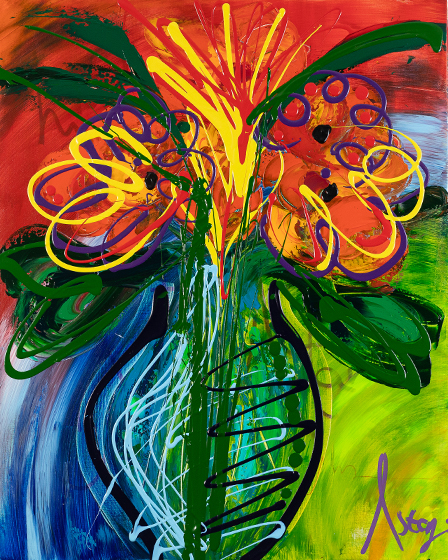
Astar Cohen
Will Bloom Again | Acrilic Painting on Canvas
Astar Cohen discovered her passion for art during the coronavirus crisis. She became aware of the beauty inherent in abstract and intuitive expressionist painting, as an expressive-therapeutic tool. A tool that connects her daily life with her inner world, using optimistic and positive colors to liberate and express her soul.
Cohen’s paintings are typified by strong colors and the spread of color in a way that combines deliberate impasto with color-dripping that breaks the texture of the painting as a uniformly composed surface. Like a poet, choosing to integrate words expressing his or her feelings while simultaneously touching the emotions of the audience.
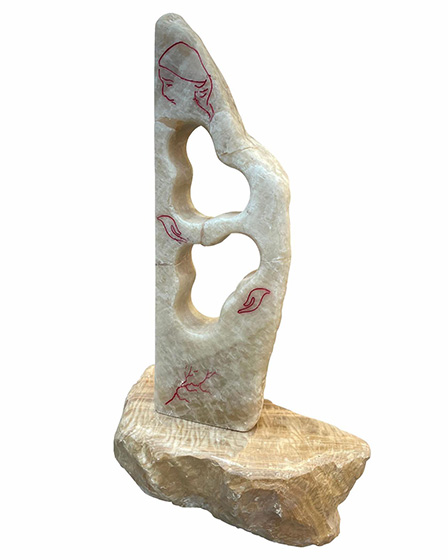
Eshed Winkler
Mother
The figure of a mother, protecting her two children with her hands, and the lightning that struck her out of the blue. Inspired by the image engraved in all our memories and hearts – Shiri Bibas and her two children after their abduction.
The sculptor Eshed Winkler sculpts and creates in stone, emphasizing maintaining a clean and abstract line with attention to small details. Winkler is a fourth-generation artist and stone mason.
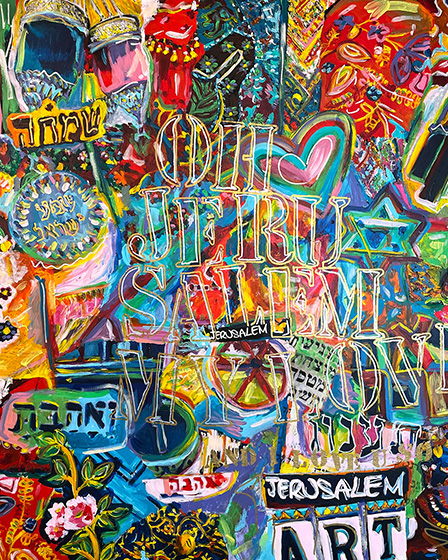
Gil Goren
Multimedia Artist
Hope is an expectation for something to come true. Hope is a prayer, a request. In Israel’s national anthem, the hope is to be a free people in our land, the Land of Zion and Jerusalem. In these days of prayer and anticipation of good, I chose to present three different works relating to the word “hope”: “Hope” – our country and its colors. “I Love JLM” – the Land of Zion in its finest details. “Amen” – common to all religions in every prayer. Hoping for better days…
Since 2015, Goren has exhibited in dozens of art exhibitions and fairs in Israel and around the world. Beyond his creations, he is regularly invited for artistic collaborations with fashion companies and various architectural projects.
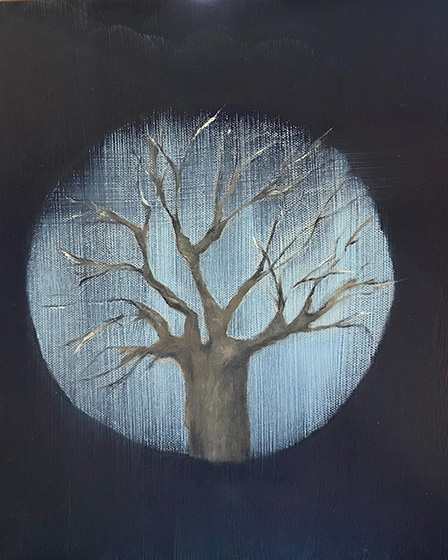
Hilary Piten
Oil on Canvas
“I paint what my inner eye sees. I try to see through or beyond the many layers that cover and hide our existence. I paint in oil, with bold brush strokes; layers that simultaneously reveal and hide. The transparencies I create allow me to produce shadows that draw the observer’s eye into the very soul of the painting, out of my desire to hint at aspiration and hope for better days.”
Hilary Piten paints portraits. She is attracted to facial expressions and to the unfiltered inner truth reflected in the eyes of her subjects – “I paint what my inner eye sees.”
Piten’s portraits tell the silent stories of her characters, and try to see beyond the myriad layers that cover and hide their beings.
Piten paints in oil on huge canvases, with strong, colorful brush strokes in layers that simultaneously reveal and hide. Her acrylic-inspired transparencies allow her to produce shadows that draw the observer’s eye into the very soul of the painting.
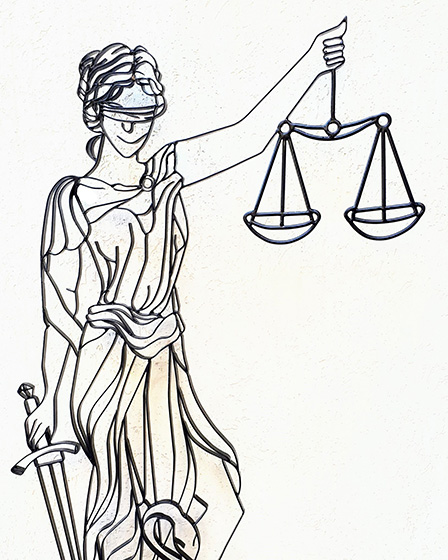
Ziv Ringer
Cast Iron Sculpture
“I sculpt in iron, which is a tough material, but I subdue it to my will using self-developed techniques. For this exhibition, I created a mini-series dealing with hope. The first sculpture is a woman’s figure trapped inside a window frame, managing only to peek outside. The second combines a variety of figures, people imprisoned within a frame. Each figure reflects an emotional aspect of an existential state. The third work is called “The Goddess of Justice,” and I chose to present her with her eyes covered and holding a sword. In my art, I weave symbols and hints for the observer to decipher.”
Ziv Ringer creates figurative and abstract ironworks.
His creations, combining classical and modern metalwork, confront the iron, imposing upon it forms and situations, testing its limits and bestowing it with soul and character.
Ringer’s experiences, impressions, conversations, and sensations spark raw ideas, which gradually develop into works of art.
He utilizes AI tools, combining surreal, humorous and even macabre elements in his work to arouse a range of emotions in the observer – from empathy, wonder and sniggering to sorrow or repulsion.
Ringer’s extensive opus is displayed in his home in Tel Aviv and in private collections.
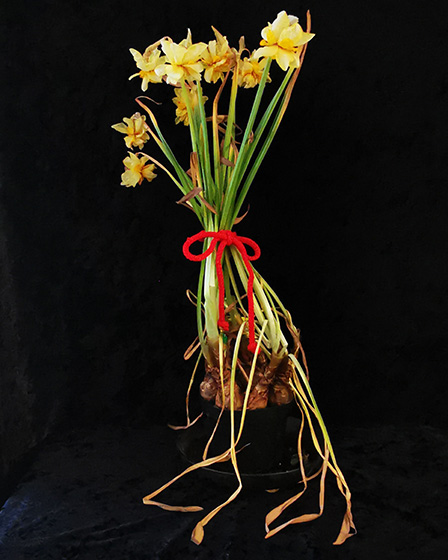
Hanan Shafir
Photography
I’ve always been optimistic. My friends would call me ‘unsaddable.’ This is also reflected in my photographs. Recently, the general mood has been rock bottom. Nevertheless, I discovered that my colorful photographs capture the moment between destruction and renewal, full of life and beauty. In retrospect, I can identify this trend of searching for the positive, the amusing, the non-trivial, and the special, as a golden thread throughout my photographs. Sometimes, placing an item in an unnatural place gives it distinct power and meaning. I hope these photographs in the “Shades of Hope” exhibition will fill observers with positive feelings and optimism.
58 years ago, when he was 10 years old, Hanan Shafir received an old Russian camera from his parents. He has been taking pictures ever since.
His photographs are characterized by a constant search for the positive, amusing, non-trivial and special.
Some of the photographs exude a sense of emptiness, influenced by the complex situation in Israel, but most of them are characterized by concealed humor, surprising reality or uncommon perspective. Sometimes this is done by placing an item in an unnatural place, giving it distinct power and meaning.
Shafir’s works were photographed in diverse locations in Israel, from his own garden to the Botanical Gardens in Jerusalem.
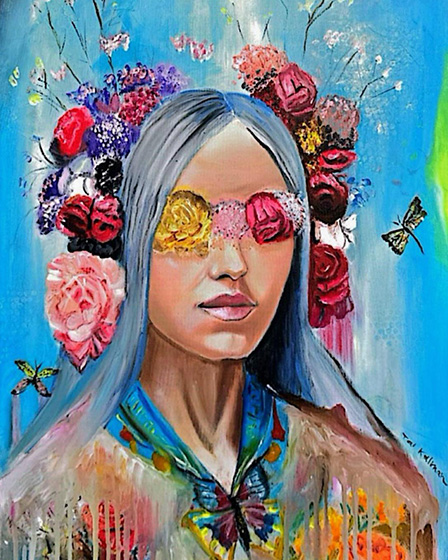
Tal Kalman
Painting Combined with Lyrical Text
“My palette is bursting with color. I love vibrant, unrestrained colors, barely diluted and unapologetic. I am captivated by beauty and want to make my observers drown in waves of aesthetics. When they look at the painting, I want them to feel the flight towards the horizon, like open air over the sea. As an artist, my aspiration is to lift people’s spirits. To remind them that layers of pain, fear and failure are not who we really are. Through my art, combining optimistic painting with lyrical texts (that I write in correlation to the pictorial imagery), I hope to arouse a spark of magic in the viewer, which can give hope for a happy life.”
Kalman uses AI in her current creative process. She creates her imagined image through AI, paints it on canvas, while changing colors, textures, etchings, and drips.
Her goal as an artist is to lift people’s spirits – “To remind them that layers of pain, fear and failure are not who we really are, and to create life, love, beauty and connection, and to give them hope instead.”
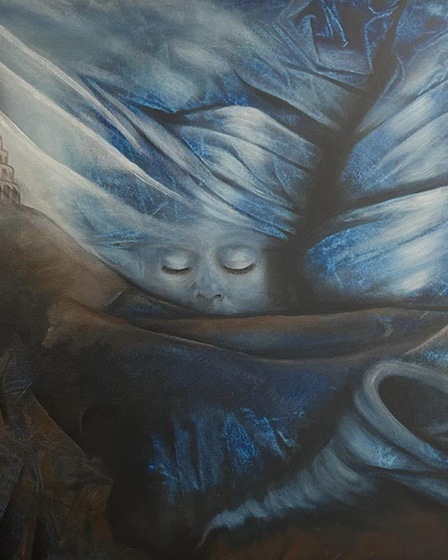
Lea Gul
“In this painting, created especially for the exhibition at Mamilla Hotel Gallery, I try to express how important intellect is to the foundation of hope. Kabbalah teaches us that the Hebrew words for “I,” “nothing,” and “eye” are strongly connected to each other. And sometimes we think we see things clearly, as if reflected in a mirror. Even at those times, we need to try to see, understand and judge from seven different perspectives, just like God. The thought that strengthens me during these times is that shades of hope are our only starting point for healing. From a sense of hope, we will overcome everything, as we always have… and will do until the end of days.”
The painter Lea Gul reinvents herself with each painting; in every creation, she reveals another facet of herself, drawn from her tumultuous life story. Gul was born in Istanbul, Turkey, into a Muslim family. After seeking meaning across the globe, she finally found it in the Jewish sacred world and converted to Judaism.
Gul has participated in numerous group exhibitions and has even held solo exhibitions in her hometown of Istanbul, where she made a name for herself as a groundbreaking artist. She tends to paint on large canvases that immerse the viewer in the work. Her color palette is vibrant and varied, and she is not afraid to experiment, make mistakes, and expose herself. The images in her paintings echo her life story; her children, her femininity, and the sacred stories she transforms into enchanting and mysterious images.
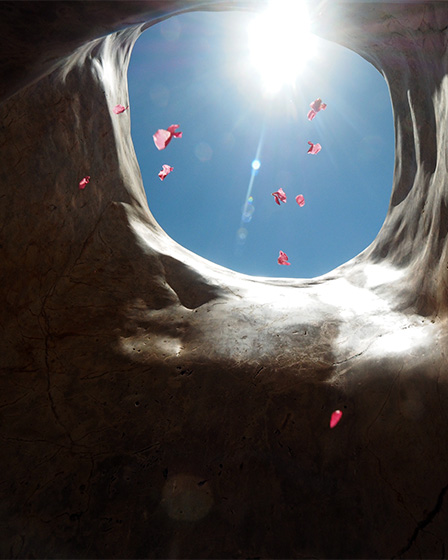
Matti Halili
Photography
Matti Halili, a native of Kibbutz Mishmar HaEmek, is one of the most prominent second-generation photographers in the kibbutz movement. The subjects he immortalizes, with a sharp, unique eye and humor, deal with Israeli life and landscapes.
For years, he has documented life in his kibbutz, Mishmar HaEmek, a community that advocates the cooperative, a gradually disappearing world. His works are immersed in the search for light, color and movement, both in nature and in humanity.
He has participated in group exhibitions in Israel and abroad. In 2012, he published a book of art entitled “For the Sake of Appearance,” which includes a selection of his works, and his second book, “What the Eyes See,” was published in 2016.